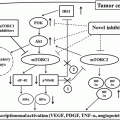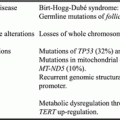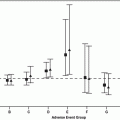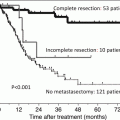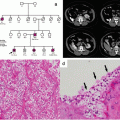© Springer Japan KK 2017
Mototsugu Oya (ed.)Renal Cell Carcinoma10.1007/978-4-431-55531-5_77. Natural History and Active Surveillance
(1)
Division of Urology, Departments of Surgery and Surgical Oncology, Princess Margaret Hospital, University Health Network, University of Toronto, 610 University Avenue, 3-124, Toronto, ON, M5G 2C4, Canada
(2)
Department of Urology, University Hospital Ayr, NHS Ayrshire and Arran, Ayr, Scotland, UK
(3)
Department of Urology, University of Sherbrooke, Sherbrooke, QC, Canada
Abstract
The last three decades have seen an increase in the detection of all stages of renal cancers due to widespread imaging. However, the largest increase is seen in cancers less than 4 cm. Surgery, either radical or partial nephrectomy, has been the mainstay of treatment of a small renal mass (SRM), defined as a usually incidentally discovered renal mass <4 cm in diameter which enhances on contrast imaging. There is morbidity associated with this standard of care. However, there has been a change in the management paradigm as a result of observations made on the natural history of SRMs. It is now known that 20–30 % are not cancer and histologically benign. This has been demonstrated with surgical series and with data from renal tumour biopsies which have been increasingly performed in the last decade. Even in SRMs proven to be renal cell carcinomas (SRMRCC), the vast majority are low grade and grow slowly. Metastatic progression also appears to be a rare and late event. Initial active surveillance (AS) has therefore emerged as an attractive management option in patients with small renal cancers, especially in elderly patients or those unfit for surgery. Our chapter presents the natural history of the SRMRCC, the current data with renal tumour biopsy and the experience with active surveillance including criteria, suggested protocols and triggers for treatment, and future directions in the changing landscape of renal cancer.
Keywords
Small renal massActive surveillanceRenal tumour biopsyNatural history7.1 Small Renal Mass
For nearly 50 years since the time when Charles Robson from Toronto first demonstrated excellent outcomes with radical nephrectomy for early and locally advanced renal cell carcinoma (RCC), surgery has become the standard of treatment for suspected malignant neoplasms of the kidney [1]. The advent of newer imaging modalities, notably CT scans, in the 1970s and subsequent widespread uptake in the 1980s led to an increased detection of incidental renal masses [2, 3]. This was mirrored by an increase of clinical stage migration over time, with initial series reporting a diagnosis of ‘incidentalomas’ of about 7 % in the 1970s, going up to 25 % in the 1980s and 50–60 % in the 1990s [2, 4]. Currently, the detection rate of incidental renal cancers in contemporary series can be as high as 70 % [5].
Most of these asymptomatic renal masses are small renal cancers <3–4 cm in size. However, we now know that up to 20–30 % of tumours <4 cm thought to be renal cancer are actually benign. This rate increases with smaller tumours with 46 % of tumours less than 1 cm being benign [6].
The term ‘small renal mass’ (SRM) was popularised in 2000 which aptly describes the radiological entity as an enhancing solid renal mass <4 cm, rather than make an upfront cancer diagnosis which could be false in a third of cases [7]. When a SRM is histologically confirmed to be RCC, it is referred to as SRMRCC. Whereas previously this term was mainly applied post-operatively, nowadays this diagnosis can be made with renal tumour biopsy (RTB) before making a treatment decision. This also lays the foundation for possible active surveillance (AS) strategies in suitable patients.
The natural history of these SRMs was not known well previously. In the 1940s, Bell postulated in his observations of renal tumours that any lesion <3 cm in size should be regarded as a benign adenoma, due to their indolent behaviour [8]. In the 1970s, Bennington rejected this theory and stated that most of these small lesions were not adenomas but merely small RCCs [9]. However, retrospective studies on SRMs since then showed that tumours less than 3 cm seldom metastasised and had a slow growth rate [10–12].
7.2 Active Surveillance
Traditionally due to the stigma associated with a diagnosis of cancer of a fear of death, clinicians and patients have sought aggressive treatments for this disease. More recently, due to advances in diagnostic and therapeutic medicine, we have understood the natural history of various cancers and now know that many cancers are diagnosed that are not inevitably fatal. As a result, active surveillance (AS) has emerged as a management option for such cancers with an indolent behaviour in many patients. This strategy has averted overtreatment of various localised cancers, such as prostate, breast, kidney and thyroid, all of which could bear a cost to the patient as well as to global health systems [13]. Even where intervention is deemed necessary, radical treatment options have seen an evolution of organ- and function-preserving treatment options. For example, breast cancer was treated with a radical mastectomy a century ago, which was quite a disfiguring and disabling procedure associated with significant morbidity. This was subsequently modified to a less radical surgery, and nowadays, suitable patients get offered a lumpectomy. The same has occurred with radical and partial nephrectomy for RCC. However, many patients prefer the option of altogether deferring treatment until it appears necessary where intervention does not appear to alter the ultimate oncological outcome, as this is associated with a lesser morbidity than even the least invasive intervention.
Active surveillance is defined as closely monitoring the disease actively for any signs of progression with the option of delayed curative treatment before size precludes local therapy or metastatic progression occurs which in the case of RCC is usually fatal. Often AS evolves into watchful waiting where the default treatment may not necessarily be a curative treatment, as happens in an aging population with competing comorbidities and where radical treatment may be hazardous. Before offering AS as a management option to patients with RCC, clinicians have to be cognisant of the evidence and limitations, described below, and have a discussion with the patient about the pros and cons of surveillance versus initial treatment.
With the advent of more personalised medicine, the future holds promise of further developments to identify those patients in whom AS will fail due to rapid progression.
7.2.1 The Evidence for Active Surveillance for Small Renal Masses
The initial evidence for AS for SRMs comes from small series of retrospective data based on observations that unbiopsied small renal tumours were noted to have slow growth rates on serial imaging. A retrospective study by Birnbaum and colleagues of 13 SRMs of ≤3 cm in 11 patients followed up over a period of up to nearly 8 years showed an average growth rate of 0.5 cm/year. Seven of the 11 patients underwent surgery, and the histology showed low-grade RCCs in the majority [11].
A subsequent series, also retrospective, by Bosniak on 37 patients with 40 parenchymal renal tumours followed up for a mean of 3.25 years showed a growth rate of 0.36 cm/year with no patient developing metastases [12].
The first prospective study of the natural history of SRMs was performed by Rendon and Jewett in a small series of 13 patients who were either unfit for or declined surgery and showed that most SRMs grow at a low rate or not at all. They used tumour volume in addition to maximal axial diameter, with an average growth rate of 0.216 cm/year at a median follow-up of 3.5 years [7]. Again, no patients developed metastases in this series, although the authors concluded that those renal tumours that are destined to metastasise appear to do so early. This was followed by an update on 32 masses in 29 patients by the same group followed prospectively for a median of 2.3 years, which again showed that in the majority of patients, the average growth rate did not differ statistically from zero growth [14]. One-third of cases proceeded to surgical excision, either due to an accelerated growth rate or patient choice; however, no patient experienced progression to metastatic disease.
Several studies were performed subsequently. A study from Japan on 18 patients who were observed for 12 months and then underwent surgery also confirmed that most small RCCs are slow-growing and that the growth rate correlates with apoptosis and grade [15]. The concept of observing renal masses has also been extended to larger masses in patients who were elderly and had severe comorbidities and therefore medically unsuitable for nephrectomy in a Scottish series of 36 patients by Lamb and colleagues. The mean age was 76 years with a median tumour size of 6 cm, with an average growth rate of only 0.39 cm/year, showing that observation in such patients is a safe option. Only one case of metastatic progression was evident at a median follow-up of 2 years [16]. This notion of observing renal masses in the elderly was further supported by a series of 110 patients aged 75 or more with enhancing renal masses who were observed for a median of 2 years. None of the patients who had a median age of 81 years died from their renal mass. The mean tumour growth rate was 0.26 cm/year, with only 3.6 % of patients receiving treatment due to increasing lesion size [17]. However, there was no histological diagnosis from biopsies, unlike Lamb’s series where two-thirds of patients were biopsied, with the vast majority showing RCC.
A meta-analysis of 10 studies on observed SRMs comprising 234 patients by Chawla and colleagues in 2004 showed a mean growth rate of 0.28 cm/year at a median follow-up of 2.8 years [18]. The mean lesion size was 2.6 cm. However, only 46 % of cases had a confirmed pathological diagnosis, of which 92 % was RCC [18]. The metastatic progression rate from this meta-analysis was 1 %. A subsequent meta-analysis of 6471 SRM lesions comparing nephron-sparing surgery, thermal ablation and observation showed no statistical differences in the incidence of metastatic progression regardless of whether the lesions were excised, ablated or observed [19].
As the momentum for AS for SRMs picked up after these initial observations, studies with larger patient numbers were done. A series of 172 renal tumours in 154 patients who were observed for a median of 2 years showed a low metastatic progression of 1.3 % [20]. A multicentre prospective trial of AS of 209 SRMs in 178 patients who were elderly or infirm showed local progression in 12 % with metastatic progression ion 1.1 % at a median follow-up , with an average growth rate of 0.13 cm/year, with no difference between biopsy-proven malignant and benign lesions. Needle core biopsies in 101 lesions confirmed a malignant and benign diagnosis in 55 % and 12 %, respectively, with 33 % being non-diagnostic. About 26 % and 10 % of observed SRMs showed regression or zero growth in size, respectively [21].
A systematic review and pooled analysis of 880 patients with 963 masses again showed that a substantial proportion of SRMs remained static after initial AS. Progression to metastases occurred in only 2 %, generally as a late event. Delayed intervention in patients suitable to receive this could be offered to those that demonstrated significant linear or volumetric growth [22].
A retrospective study by Patel and colleagues from Oxford on 202 patients with SRMs managed by AS versus surgery showed no significant difference in overall or cancer-specific survival at a median follow-up of 2.8 years. The mean growth rate was 0.21 cm/year for observed masses, with 53 % of SRMs demonstrating negative or zero growth [23].
The recent study from the multi-institutional Delayed Intervention and Surveillance for Small Renal Masses (DISSRM) prospectively enrolled 497 patients with solid SRMs <4 cm in size who chose either AS or primary intervention. Whereas overall survival (OS) at 2 years was no different, patients undergoing AS had a worse 5-year OS of 75 % compared with 92 % for primary intervention. However, there was selection bias as patients who chose AS were older and had more comorbidities and worse performance status. Interestingly, the 5-year cancer-specific survival was 99 % for intervention and 100 % for AS [24].
So far, as discussed, the evidence for AS as a reasonable and sound strategy for elderly and infirm patients unsuitable for intervention has come largely from observational series, both retrospective and prospective, with a few meta-analyses or systematic reviews of the same. Some studies, also observational series, have looked at the merits of delayed intervention in those fit to receive them in patients demonstrating rapid interval growth and found initial AS as a relatively safe option. Whether AS is a safe strategy for all SRMS remains to be confirmed with evidence by way of randomised trials which is currently lacking.
The one challenge that all clinicians face is defining progression for patients on AS. Currently there are no reliable markers of progression that would help predict which SRMs will metastasise, which is relevant in patients who may benefit from curative interventions [22]. The uptake of renal tumour biopsies may help to better define the nature of SRMs where a diagnosis is made and the grade of tumour where a malignant diagnosis is made. This is discussed in detail in Sect. 7.3.
7.2.2 Prognostic Factors for Progression and Treatment Triggers
Currently, apart from the development of metastases, there is no validated confirmatory clinical or molecular marker of progression of a SRM-RCC on AS. The rate of metastatic progression has been demonstrated to be as low as 1.1 % in the prospective Canadian trial [21] and 2 % in a pooled analysis and systematic review of 880 patients [22]. Where biopsy is diagnostic, the type and grade of RCC can help prognosticate and tailor follow-up protocols. Unlike prostate cancer, where a repeat biopsy for men on AS can help identify grade progression, this is not routinely done for SRMs. Hence, clinical stage progression on surveillance imaging coupled with growth rate is used as a surrogate for progression.
7.2.2.1 Patient Age
Age is important when selecting patients for AS or watchful waiting. The majority of patients with sporadic RCC present after the sixth decade of life. The presence of comorbidities is proportionate to increasing age and performance status and general fitness inversely proportionate. This would clearly impact on the choice of treatment. AS of SRMs is currently recommended for patients with a reduced life expectancy or in those deemed unfit for surgical treatment. In some selected cases, minimally invasive treatments such as thermal ablation by cryotherapy or radiofrequency ablation could be offered.
Stay updated, free articles. Join our Telegram channel

Full access? Get Clinical Tree




